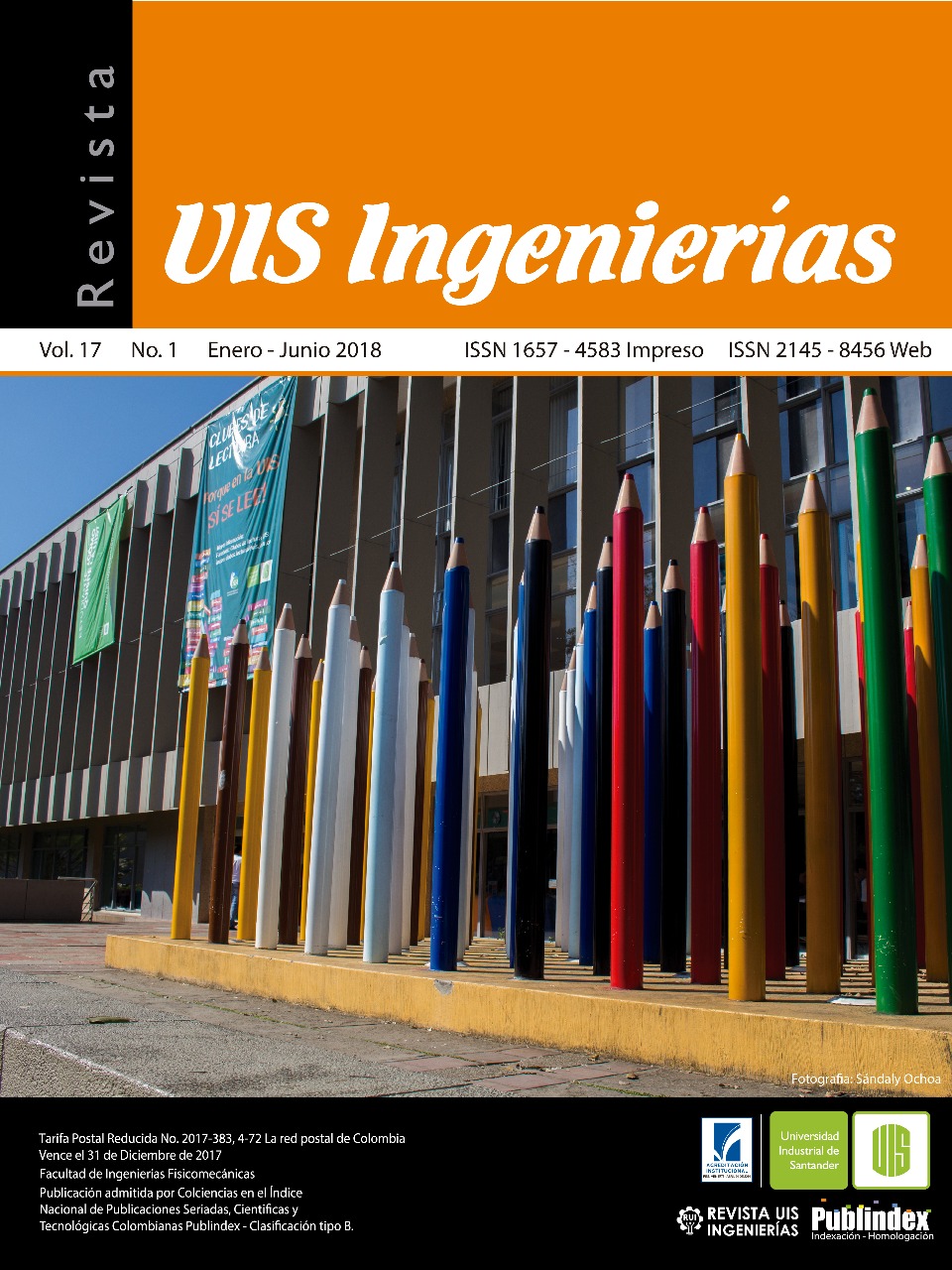Articles
Structures assembly in the mesoscale: non-symmetric trimers formation
Published 2018-01-10
Keywords
- Fokker-planck,
- mesoscale,
- non-equilibrium thermodynamics,
- structures assembly
How to Cite
Arango-Restrepo, A., & Barragán, D. (2018). Structures assembly in the mesoscale: non-symmetric trimers formation. Revista UIS Ingenierías, 17(1), 163–168. https://doi.org/10.18273/revuin.v17n1-2018015
Abstract
Structures assembly takes place from molecular to cosmological scale. The building of structures comes up from fundamental and discrete components. In this work we study the formation of molecular non-symmetric trimers at the mesoscale. The assembly process is modeled by a set of Fokker-Planck type equations coupled through the boundary conditions. The mathematical model is solved in the space of trajectories where the probability of assembling is evaluated. Obtained results show how the assembly process depends on the boundary conditions and the shape of energy barriers.
Downloads
Download data is not yet available.
References
B. Grzybowski, C. Wilmer, J. Kim, K. Browne and K. Bishop, “Self-assembly: from crystals to cells”, Soft Matter, vol. 5, no. 6, pp. 1110, Feb., 2009.
M. Fialkowski, K. Bishop, R. Klajn, S. Smoukov, C. Campbell and B. Grzybowski, “Principles and Implementations of Dissipative (Dynamic) SelfAssembly”, The Journal of Physical Chemistry B, vol. 110, no. 6, pp. 2482-2496, Mar., 2006.
J. Lehn, “Toward Self-Organization and Complex Matter.” Science, vol. 295, pp.2400-2403, Mar., 2002.
G. M. Whitesides and B. A. Grzybowski, “SelfAssembly at All Scales.” Science, vol. 295, pp.24182421,Mar., 2002.
R. Greenberg and A. Brahic, Planetary rings. Tucson, Arizona: The university of Arizona Press, 1984.
S. Mann,“Self-assembly and transformation of hybrid nano-objects and nanostructures under equilibrium and nonequilibrium conditions”, Nature Materials, vol. 8, no. 10, pp. 781-792, Oct., 2009.
K. Tretiakov, K. Bishop and B. Grzybowski, “The dependence between forces and dissipation rates mediating dynamic self-assembly”, Soft Matter, vol. 5, no. 6, p. 1279, Ene., 2009.
K. Tretiakov, I. Szleifer and B. Grzybowski, “The Rate of Energy Dissipation Determines Probabilities of Non-equilibrium Assemblies.” Angewandte Chemie, vol. 125, no. 39, pp. 10494-10498, Sep., 2013.
P. Jha, V. Kuzovkov,B. Grzybowski andM. Olvera de la Cruz, “Dynamic self-assembly of photo-switchable nanoparticles.” Soft Matter, vol. 8, no. 1, pp. 227-234, Nov., 2011.
D. Reguera, J. Rub´ı and J. Vilar, “The Mesoscopic Dynamics of Thermodynamic Systems,” The Journal of Physical Chemistry B, vol. 109, no. 46, pp. 21502-21515, Oct., 2005.
A. Arango-Restrepo, “Non-equilibrium selfassembly processes: Thermodynamics of structures formation out of equilibrium,” Tesis de Máster, Dept. Química, Universidad Nacional de Colombia, Medellín, Colombia, 2017.
H.A. Kramers,“Brownian Motion in a Field of Force and the Diffusion Model of Chemical Reactions,” Physica, vol. 7, no. 4, pp. 284-304, Abr., 1940.
H. Estupíñan, C. Vásquez, L.F. Ardila, “Degradación de ácido poliláctico / hidroxiapatita y ácido poliglicólico en fluido corporal simulado,” Rev. UIS Ing., vol. 10, no. 2, pp. 145-150, 2011.
Y. Rueda-Ordoñez, K. Tannous, “Análisis cinético de la descomposición térmica de Biomasa Aplicando un Esquema de Reacciones Paralelas Independientes,” Rev. UIS Ing., vol. 16, no. 2, pp. 119-127, 2017.
D. P. González, C. A. Villabona, H. R. Vargas, E. Ariza, C. E. Roa, C. Brajas, “Métodos para el Control e Inhibición de la Acumulación de Depósitos Parafínicos,”Rev. UIS Ing., vol. 9, no. 2, pp. 193-206, 2010.
M. Fialkowski, K. Bishop, R. Klajn, S. Smoukov, C. Campbell and B. Grzybowski, “Principles and Implementations of Dissipative (Dynamic) SelfAssembly”, The Journal of Physical Chemistry B, vol. 110, no. 6, pp. 2482-2496, Mar., 2006.
J. Lehn, “Toward Self-Organization and Complex Matter.” Science, vol. 295, pp.2400-2403, Mar., 2002.
G. M. Whitesides and B. A. Grzybowski, “SelfAssembly at All Scales.” Science, vol. 295, pp.24182421,Mar., 2002.
R. Greenberg and A. Brahic, Planetary rings. Tucson, Arizona: The university of Arizona Press, 1984.
S. Mann,“Self-assembly and transformation of hybrid nano-objects and nanostructures under equilibrium and nonequilibrium conditions”, Nature Materials, vol. 8, no. 10, pp. 781-792, Oct., 2009.
K. Tretiakov, K. Bishop and B. Grzybowski, “The dependence between forces and dissipation rates mediating dynamic self-assembly”, Soft Matter, vol. 5, no. 6, p. 1279, Ene., 2009.
K. Tretiakov, I. Szleifer and B. Grzybowski, “The Rate of Energy Dissipation Determines Probabilities of Non-equilibrium Assemblies.” Angewandte Chemie, vol. 125, no. 39, pp. 10494-10498, Sep., 2013.
P. Jha, V. Kuzovkov,B. Grzybowski andM. Olvera de la Cruz, “Dynamic self-assembly of photo-switchable nanoparticles.” Soft Matter, vol. 8, no. 1, pp. 227-234, Nov., 2011.
D. Reguera, J. Rub´ı and J. Vilar, “The Mesoscopic Dynamics of Thermodynamic Systems,” The Journal of Physical Chemistry B, vol. 109, no. 46, pp. 21502-21515, Oct., 2005.
A. Arango-Restrepo, “Non-equilibrium selfassembly processes: Thermodynamics of structures formation out of equilibrium,” Tesis de Máster, Dept. Química, Universidad Nacional de Colombia, Medellín, Colombia, 2017.
H.A. Kramers,“Brownian Motion in a Field of Force and the Diffusion Model of Chemical Reactions,” Physica, vol. 7, no. 4, pp. 284-304, Abr., 1940.
H. Estupíñan, C. Vásquez, L.F. Ardila, “Degradación de ácido poliláctico / hidroxiapatita y ácido poliglicólico en fluido corporal simulado,” Rev. UIS Ing., vol. 10, no. 2, pp. 145-150, 2011.
Y. Rueda-Ordoñez, K. Tannous, “Análisis cinético de la descomposición térmica de Biomasa Aplicando un Esquema de Reacciones Paralelas Independientes,” Rev. UIS Ing., vol. 16, no. 2, pp. 119-127, 2017.
D. P. González, C. A. Villabona, H. R. Vargas, E. Ariza, C. E. Roa, C. Brajas, “Métodos para el Control e Inhibición de la Acumulación de Depósitos Parafínicos,”Rev. UIS Ing., vol. 9, no. 2, pp. 193-206, 2010.

